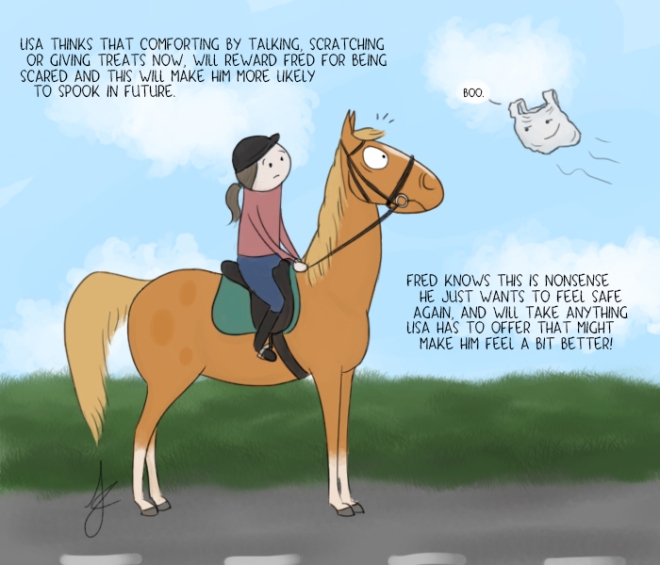You Can’t Reinforce Fear
Fear is an emotion, not a behaviour. It is subject to classical conditioning (the way we form associations between different things) rather than operant conditioning (how we learn by the consequences of our behaviour). To be operantly conditioned a behaviour has to be something the animal chooses to do voluntarily rather than involuntarily. For example, a person, a dog, a horse cannot choose not to be afraid. That feeling is an involuntary and automatic response to a feared thing or situation. Everyone who has ever feared anything knows that we cannot control how we feel in that moment. Anyone who has ever been a nervous rider can relate to that. A classically conditioned response is controlled by the things that come before it – the things that trigger that feeling (known as the antecedents). An operant response is reinforced or weakened by what comes after it – its consequences.

As trainers we can choose to control or act on the environment in order to reduce the fear the animal is experiencing. For example we can use words/actions/gestures that in the past have been associated with safety/calm/pleasure. We can use them in an emergency situation to calm and reassure as best we can, and we can use them in a longer term plan as counter-conditioning. Counter-conditioning is a form of classical conditioning that involves following a very very low strength version of the feared thing with something very desirable – like following the far off sound of clippers being turned on, with a handful of carrot to a horse that is afraid of the clippers.
If you are worried that it is possible to positively reinforce fear, ask yourself this. When your horse is fearful or worried and heads to you for comfort, does you comforting them with a stroke or food make them more afraid? Does not comforting them make them less afraid? If comforting them reinforces fear, they will become more afraid as a result of our soothing them than they would if we didn’t do anything at all. Practically, we can see how that works – and if it doesn’t, and our horse becomes more afraid, we might need to look at how they view us, rather than worry about whether comforting them is strengthening their fear response.
A typical example where we’re told not to comfort our horses is spooking or shying. People who do not understand how any of this works might tell you “Don’t pat or stroke them on the neck and go there, there, it will make them more likely to spook”. It won’t.
Ditch From Hell
I came across this “funny” viral video on my newsfeed a couple of times, showing a horse making a theatrical jump over a ditch after being kicked in the sides while the reins kept him from looking at the thing that was scaring him.
“Tactfully ridden” .. “Trust issue” .. “Lol”
Trust must be one of the most misused words in the equestrian world. The word you’re probably looking for is ‘force’ or ‘intimidation’.

Pig Phobia
Check out the Fairhorsemanship article about dealing with fear, anxiety and phobias in horses here.





